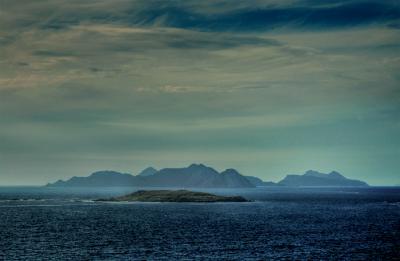Islas Cies.

Castellano:
Las Islas Cíes, que pertenecen al municipio de Vigo,forman un archipiélago en las Rías Bajas gallegas, en la Provincia de Pontevedra (España). Fueron declaradas parque natural en 1980, y están incluidas en el Parque Nacional de las Islas Atlánticas de Galicia creado en 2002.
En el mes de febreo del año 2007 el periódico británico The Guardian eligió la playa de Rodas, en la isla de Monteagudo, como "la playa más bonita del mundo".
Este archipielago, está formada por tres islas llamadas:
- Monteagudo
- Do Faro
- San Martiño
Vida y fondos marinos:
La zona submarina que rodea Cíes, es uno de los ecosistemas más ricos de la costa gallega. Lo que más destaca es un importante bosque de algas pardas.
El perímetro de las islas tiene diferentes tipos de entornos: los acantilados, expuestos al fuerte oleaje, están poblados por percebes y mejillones. En su parte submarina, de piedra, se pueden encontrar nécoras, centollos, bogavantes y pulpos. En las playas de las zonas más protegidas hay multitud de moluscos bivalvos, así como rodaballos, sollas y lenguados. Las zonas rocosas pero protegidas del interior de las islas están pobladas por verdaderos bosques de anémonas y numerosos erizos de mar.
Historia:
En la antigüedad fueron llamadas Siccae (áridas). Se han encontrado en las Cíes restos arqueológicos que datan la presencia humana sobre el 3500 a. C., si bien los restos del primer asentamiento humano de que se tiene constancia son un castro de comienzos de la Edad de Hierro.
Por allí pasaron los romanos, dejando restos como un anillo de oro datado en el siglo II de nuestra era, así como ánforas, cerámica y diversos útiles que se exponen hoy en el Museo de Pontevedra.
Inglés:
Cies Islands, belonging to the municipality of Vigo, form an archipelago at the mouth of the estuary of the same name, in the Galician Rias Baixas in the province of Pontevedra (Spain). They were declared a Natural Park in 1980, and is included in the National Park of the Atlantic Islands of Galicia was established in 2002.
In the month of Febreo of 2007 the British newspaper The Guardian chose the beach of Rhodes, on the island of Monteagudo, as "the most beautiful beach in the world’’.
This archipelago, consists of three islands called:
- Monteagudo
- Do Faro
- San Martino
Life and seabed:
The underwater area surrounding Cies, is one of the richest ecosystems on the Galician coast. What stands out is an important kelp forest.
The perimeter of the islands have different kinds of environments: the cliffs, exposed to strong waves, are populated by barnacles and mussels. In its underwater part of stone, you can find crabs, spider crabs, lobsters and octopuses. On the beaches of the most protected areas there are many bivalve mollusks, and turbot, plaice and sole. The rocky areas but protected the interior of the islands are populated by forests of anemones and many sea urchins.
History:
In ancient times were called Siccae (dry). Found in archaeological remains Cíes human presence on the 3500 a. C., while the remains of the first human settlement on record are a fort of the early Iron Age.
For the Romans went there, leaving traces as a gold ring dating from the second century AD, as well as vases, pottery and various tools that are presented today at the Museum of Pontevedra.
0 comentarios